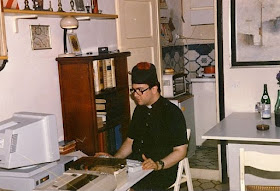Revelations of the old Holy Week rites' quasi-liberation, at least for three years, in a handful of settings has prompted various reactions among those receiving the news. Generally these reactions fall into three categories:
- A gentle, cautious curiosity about what the old liturgy is, why it left, and some level of excitement about discovering something new at one's parish at the end of Lent.
- Bugnini was a Freemason, so anything that gets rid of his influence from the "TLM" is good.
- "They better not do the 'Easter Vigil' during the daylight" crowd.
The first group hopefully finds the old rite worthy of reception and preservation after having experienced authentic traditional liturgy, but the latter group may be an issue depending on how pastors decide to implement the un-dereformed Roman rite.
As a layman who, like many Americans, is given Good Friday off by his company or who has the option of using Good Friday as a "floating holiday", I wake up hungry, bound by fasting, and have absolutely nothing to do until 3PM at the earliest, when the Pian or Pacellian novelties will be observed in a neighborhood church. Aside from the rites themselves, the timing of the Pius XII and Paul VI Holy Week liturgies seems rational, but in fact is not reasonable to anyone with a sense of time or rhythm to the day. Parishes may hold Stations of the Cross, a twenty minute exercise, at noon and then the vacuum returns for the next two and a half hours until the "Solemn Post-Noon Liturgical Action" ensues. The old liturgy usually began some time between 9AM and noon, with only a guideline to commence the Presanctified Mass after the Office of None, again typically said by noontime during Lent. This meant that the Mass of the Presanctified, which commemorates Our Lord's Passion in narrative through the Gospel of Saint John and in action by both venerating the Cross and displaying the Sacrifice of the Mass without consecration, actually coincides with the timeline throughout the day of Christ's own Passion. The 3PM start time de facto observed in parishes concludes a practical vacuum by beginning the liturgy at the time when the disciplines had left Our Savior's dead body on the Cross so they could beseech Pilate's permission to retrieve it. Moreover, there cannot be any unique pastoral justification for beginning the Mass at 3PM rather than—for instance—noon, since midday is hardly a typical time for anyone to get off work; anyone available at that time was probably available three hours ago and anyone unavailable probably will not be free until after working hours.
And then there is the "Easter Vigil", which I have hypothesized on this blog is the result of the Vesperal Liturgy of Pascha splitting into two separate days in the late first millennium, something along the lines of the split between the Baptismal Divine Liturgy of Saint Basil and the Pascal Divine Liturgy of Saint John Chrysostom in the Greek rite. The term "Easter Vigil" is a misnomer that reflects a paradigm shift in thinking about the liturgy along of the lines Saturday night Sunday Masses, wherein tomorrow's Eucharist is celebrated tonight. In some sense the Novus Ordo is more traditional in this regard, keeping the Mass and accompanying ceremonies entirely on Saturday night, while the 1962 liturgy intentionally has Holy Saturday's Mass at midnight, almost like Christmas, and celebrates it as the "first Mass" of the Resurrection.
In the old rite the Holy Saturday Mass is a Vesperal rite, meaning that it belongs to Vespers of Holy Saturday. Amazingly it retains the ancient lucernarium service, the lamp-lighting that took place during Vespers in primitive Church times. After the known rites of reading prophecies, welcoming converts, blessing water, and celebrating Mass, the services also conclude with Vespers, which from the psalm fragment sung displays that it may well be a later addendum to the now standalone service. What this does mean is that there is no pure "right time" for this service to take place, but that there are wrong times. That it ends with Vespers could mean it justifiably would end around 3PM, which is when most churches celebrated Vespers until the 20th century. That is begins with a Vespers-related service could also mean it should commence at the setting of the sun, when light is dying and when the early Church brightened their Vespers with lamps. What it does not mean is that it is a Paschal equivalent of a midnight Mass that should start in the pitch black of night, when small children are wont to cry because they prefer to be in bed.
Lastly, there is a pastoral matter of timing. That no one went to Holy Week rites before Pius XII is quite untrue and follows a very modern supposition that the only thing laymen ought to attend is the Mass. The Masses of Holy Week were under-attended outside of cathedrals or monastic retreats. The Offices of Holy Week were quite well attended, so well that every major composer of sacred music seems to have written responsories or settings of the Lamentations for use during their Tenebrae rites. One benefit, however, to this old timing system was that Offices and additional functions outside the Mass were available to laymen with variable schedules. Rather than force everyone into a hit or miss 3PM Good Friday "Solemn Post-Noon Liturgical Action", why not have the little hours in the morning? perhaps follow that with the Presanctified Mass at noon and Stations at 5PM for those getting off work late? and then Tenebrae in the evening? It would give those who work blue collar jobs, those in services, those in the medical profession, and those with small children substantial options that the 1962/Paul VI schema just fails to deliver except in very rare circumstances. No one wants their Holy Saturday Mass at 6AM, but no one wants it at midnight either.

.jpg)











